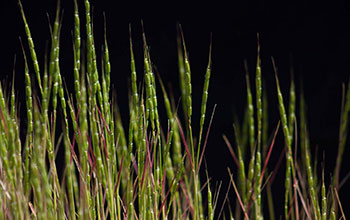Multimedia Gallery
Aegilops tauschii (Tusch's goatgrass/rough-spike hard grass)
Aegilops tauschii, also known as Tausch's goatgrass and rough-spike hard grass. Researchers from the University of California, Davis, supported by the National Science Foundation, will produce a high-quality draft of the genome of Ae. tauschii, one of the three progenitors of bread wheat.
More about this image
Bread wheat is one of three pillars on which the global food supply rests. Despite the exceptional importance of wheat, a high-quality draft reference sequence of the wheat genome is not available due primarily to its hybrid origin (polyploidy) and the enormous size of its genome.
To assist the international bread wheat genome sequencing effort, researchers from the University of California, Davis, supported by the National Science Foundation (grant IOS 12-38231), will produce a high-quality draft of the genome of Aegilops tauschii, one of the three progenitors of bread wheat.
The large size and great complexity of the Ae. Tauschii genome necessitates adopting the ordered-clone sequencing strategy for generating a high-quality genome sequence draft. This strategy will involve the sequencing of about 50,000 bacterial artificial chromosome (BAC) clones, harboring large fragments of Ae. Tauschii DNA that have been ordered to represent the contiguous sequence of nucleotides in Ae. Tauschii chromosomal DNA.
Pools of BAC clones will be sequenced with a next-generation DNA sequencing platform and assembled into long contiguous sequences. The correctness of the assembled sequences will be validated with a novel optical nanotechnique. Genes and transposable elements in the assembled sequences will be annotated. In this way, the sequence, location and orientation of all genes and transposable elements in the Ae. Tauschii genome will be determined.
Having Ae. Tauschii's genome sequenced will have an impact in predicting the location of genes in wheat and its relatives, thereby facilitating gene discovery and manipulation in these species with the goal of incorporating these genes into wheat by traditional breeding methods or biotechnology. The genome sequence will serve as a reference in analyses of genomic changes that have taken place in the wheat genome since the origin of wheat, providing significant and fundamental contributions to the understanding of grass genome structure and evolution, and accelerating progress in genome sequencing of wheat and its relatives.
The project will also engage the large research community interested in analyzing genes of Ae. Tauschiii in community-based manual gene annotation and graphical compilation of the results in a project database. (Date image taken: 2013; date originally posted to NSF Multimedia Gallery: March 1, 2018)
Credit: Patrick E. McGuire, University of California, Davis
See other images like this on your iPhone or iPad download NSF Science Zone on the Apple App Store.
Images and other media in the National Science Foundation Multimedia Gallery are available for use in print and electronic material by NSF employees, members of the media, university staff, teachers and the general public. All media in the gallery are intended for personal, educational and nonprofit/non-commercial use only.
Images credited to the National Science Foundation, a federal agency, are in the public domain. The images were created by employees of the United States Government as part of their official duties or prepared by contractors as "works for hire" for NSF. You may freely use NSF-credited images and, at your discretion, credit NSF with a "Courtesy: National Science Foundation" notation.
Additional information about general usage can be found in Conditions.
Also Available:
Download the high-resolution JPG version of the image. (603.6 KB)
Use your mouse to right-click (Mac users may need to Ctrl-click) the link above and choose the option that will save the file or target to your computer.



